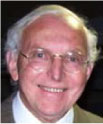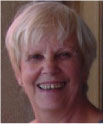The Neutron – The Curie Family's Legacy
John W. White A B and Ailsa B. White AA Research School of Chemistry, Australian National University, Canberra, ACT 0200, Australia.
B Corresponding author. Email: jww@rsc.anu.edu.au

John William White CMG, FRS, FAA, FACI obtained his B.Sc. (Hons) and M.Sc. at the University of Sydney before going to Oxford on an 1851 Scholarship to study for his D.Phil. He was elected a Fellow in chemistry at St John's College, Oxford in 1973. John has been a pioneer in the use of neutrons, developing neutron contrast variation in structure determination. In the 1970s, he was Director of the Institut Laue Langevin in Grenoble, France. In 1985, he became Professor of Physical and Theoretical Chemistry in the Research School of Chemistry at the Australian National University in Canberra, a position he still holds. John is currently President of the Asia Oceania Neutron Scattering Association, AONSA. |

Ailsa Barbara White (nee Vise) obtained her B.Sc. (Hons) and M.Sc. in microbiology at the University of Queensland before going to Oxford on a Walter and Eliza Hall Travelling Scholarship where she obtained a second M.Sc.. She married John in 1966 and, with their four children, went with him to Grenoble. In Canberra she spent 20 years in the Public Service, mostly in the Science Group of the Industry and Education Departments. |
Australian Journal of Chemistry 64(7) 855-863 https://doi.org/10.1071/CH11214
Submitted: 26 May 2011 Accepted: 1 June 2011 Published: 19 July 2011
Abstract
This article is concerned with the scientific developments that led to the discovery of the neutron by Sir James Chadwick at the Cavendish Laboratory Cambridge in 1932. The Rutherford atom with a heavy nucleus and the problem of the ‘intra-nuclear’ electrons (needed to reconcile nuclear mass and charge) coupled with Marie Curie's discovery of radium as a prime example of natural radioactivity coming from the nucleus were key milestones. Frédéric Joliot and Irène Curie–Joliot almost discovered the neutron in 1931. But the predisposition of the thinking in Chadwick's laboratory allowed conclusive identification of the emission of a heavy neutral particle to be published about a month after the Curie–Joliot experiment. Their Nobel Prize came a few years later with the discovery of artificial radioactivity.
References
[1] I. Newton, in Optiks, Bk. 3 Part 1 Query 31, based on 4th edn, 1730, p. 400 (London).[2] E. Rutherford, Philos. Mag. 1911, 21, 669, 688.
[3] N. Bohr, Philos. Mag. 1913, 26, 476, 857.
[4] E. Rutherford, F. Soddy, Philos. Mag 1903, Ser 6.V., 576.
[5] N. Feather, Cont. Phys 1960, I, 190.quoting O. Lodge's lecture to London Institution, Dec 1882.
[6] W. Sutherland, Philos. Mag. S5. 1899, 47, 269.
[7] W. Nernst, Atomistische Theorie der Elektrizitat, in Theoretische Chemie, 4th edn. 1903.
[8] E. Rutherford, Radioactivity 1904, (Cambridge University Press: Cambridge).
[9] J. Chadwick, Proc. R. Soc. 1954, A224, 435.
[10] E. Rutherford, Proc. R. Soc. 1920, A97, 379.
[11] J. L. Glasson, Philos. Mag. 1921, 42, 596.
| 1:CAS:528:DyaB38Xis12q&md5=38c832ef5dabc052ad217102a9fa4b30CAS |
[12] Personal communication, Sir J. Chadwick to N. Feather, 1959 (Feather archives: Churchill College Cambridge).
[13] G. Gamow, Z. Phys. 1928, 51, 204.
| Crossref | GoogleScholarGoogle Scholar | 1:CAS:528:DyaB1MXptVyr&md5=9596ba5f05672ded5f6450f879299ad3CAS |
[14] R. W. Gurney, E. U. Condon, Nature 1928, 122, 439.
| Crossref | GoogleScholarGoogle Scholar | 1:CAS:528:DyaB1MXisVen&md5=30cd84a89325b26887c642e8c72508f7CAS |
[15] J. Cockcroft, E. Walton, Proc. R. Soc. 1932, A137, 229.
[16] G. Gamow, The Structure of the Atomic Nucleus 1931 (Oxford University Press: Oxford).
[17] Personal communication, R. Peierls to J. W. White, June 1982.
[18] M. Oliphant, in Rutherford–Recollections of the Cambridge Days 1972, (Elsevier: Amsterdam).
[19] W. Bothe, H. Becker, Z. Phys. 1930, 66, 289.
| Crossref | GoogleScholarGoogle Scholar | 1:CAS:528:DyaA3MXhtVKhtQ%3D%3D&md5=b9a98460e675da12628cd0732999aeb1CAS |
[20] I. Curie, F. Joliot, C. R. Acad. Sci. Paris 1932, 194, 273.
| 1:CAS:528:DyaA38XhslOgtQ%3D%3D&md5=a33a82cef01655a9ee823067dfce100aCAS |
[21] J. Chadwick, Nature 1932, 129, 312.
| Crossref | GoogleScholarGoogle Scholar | 1:CAS:528:DyaA38Xit1ynug%3D%3D&md5=7c988e882c12f27d4d600b5dab39e3d8CAS |
[22] (a) (a) J. Chadwick to N. Feather, Feather Archives, 1959, 29 September.
(b) (b) J. Chadwick, Some personal notes on the search for the neutron – in 1982 the original was displayed in the entrance hall of Neutron Therapy Unit, Hammersmith Hospital, London.
(c) (c) American Institute of Physics tapes, kindly made available by Dr Spencer Weart.
[23] J. Chadwick, Proc. R. Soc. 1932, A136, 692.
[24] N. Feather, Proc. R. Soc. 1932, A136, 709.
[25] L. De Broglie, New Perspectives in Physics 1962, p. 138 translated by A. J. Pomerans. (Oliver & Boyd: London).


